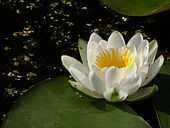Nymphaea alba
| European white waterlily | |
|---|---|
 | |
| Scientific classification | |
| Kingdom: | Plantae |
| (unranked): | Angiosperms |
| Order: | Nymphaeales |
| Family: | Nymphaeaceae |
| Genus: | Nymphaea |
| Species: | N. alba |
| Binomial name | |
| Nymphaea alba L. | |
 | |


Nymphaea alba, also known as the European White Waterlily, White Lotus, White Water Rose or Nenuphar, is an aquatic flowering plant of the family Nymphaeaceae.
It grows in water from 30-150 centimeters deep and likes large ponds and lakes. The leaves can be up to thirty centimeters in diameter and they take up a spread of 150 centimeters per plant. The flowers are white and they have many small stamens inside. It is found all over Europe and in parts of North Africa and the Middle East in freshwater.
The red variety which is in cultivation came from lake Fagertärn (Fair tarn) in the forest of Tiveden, Sweden, where they were discovered in the early 19th century. The discovery led to a large scale exploitation which nearly made it extinct in the wild before it was protected.
Nymphaea candida J. Presl is sometimes considered a subspecies of N. alba (N. alba L. subsp. candida (J. Presl) Korsh.).
It contains the active alkaloids nupharine and nymphaeine, and is a sedative and an aphrodisiac/anaphrodisiac depending on sources. Although roots and stalks are used in traditional herbal medicine along with the flower, the petals and other flower parts are the most potent. Alcohol can be used to extract the active alkaloids, and it also boosts the sedative effects. The root of the plant was used by monks and nuns for hundreds of years as an anaphrodisiac, being crushed and mixed with wine. In the earliest printed medical textbooks, authors would maintain this area of use, though warning against consuming large and frequent doses.[1]
References
- ↑ Nielsen, Giftplanter, 68-69
| Wikimedia Commons has media related to Nymphaea alba. |